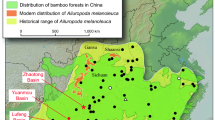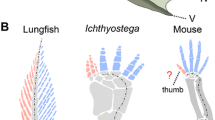Abstract
The panda’s false thumb is an iconic structure, described as one of the most shocking cases of anatomical convergence, and has been studied in many essays about evolution. However, in a recent paper in which we evaluated this feature within the Carnivora, we concluded that the developed radial sesamoid could be taken as a plesiomorphic character for at least the Arctoidea, rather than an anatomical convergence of the pandas (both red and giant). Following this argument, in this research we describe the action of a radial sesamoid as a real false thumb for the first time outside the mammalian carnivorans. The cricetid Sigmodon peruanus shows a very similar radial sesamoid compared to that of the giant panda (Ailuropoda melanoleuca) but somehow relatively even more developed, compared to the other bones of the manus than in the latter, showing that the use of this structure as a opposable pincer is much more expanded in mammals than thought previously.







Similar content being viewed by others
References
Abella J, Pérez-Ramos A, Valenciano A, Alba DM, Ercoli MD, Hontecillas D, Montoya P, Morales J (2015) Tracing the origin of the panda’s thumb. The Science of Nature-Naturwissenschaften 102(5):35
Allen JA (1897) On a small collection of mammals from Peru, with descriptions of new species. Bull Am Mus Nat Hist 9:115–119
Antón M, Salesa MJ, Pastor JF, Peigné S, Morales J (2006) Implications of the functional anatomy of the hand and forearm of Ailurus fulgens (Carnivora, Ailuridae) for the evolution of the ‘false-thumb’ in pandas. J Anat 209:757–764
Bowdich TE (1821) An Analysis of the Natural Classifications of Mammalia, for the Use of Students and Travellers. J. Smith, Paris
Carrizo LV, Catalano SA (2015) First phylogenetic analysis of the tribe Phyllotini (Rodentia: Sigmodontinae) combining morphological and molecular data. Cladistics 25 (3):211–230
Carrizo LV, Tulli MJ, Abdala V (2014a) An ecomorphological analysis of forelimb musculotendinous system in sigmodontine rodents (Rodentia, Cricetidae, Sigmodontinae). J Mammal 95:843–854
Carrizo LV, Tulli MJ, Dos Santos DA, Abdala V (2014b) Interplay between postcranial morphology and locomotor types in Neotropical sigmodontine rodents. J Anat 224:469–481
Coutinho LC, de Oliveira JA, Pessôa LM (2013) Morphological variation in the appendicular skeleton of Atlantic forest sigmodontine rodents. J Morphol 274(7): 779–792
Choate JR, Jones JK Jr, Jones C (1994) Handbook of Mammals of the South-Central States. Louisiana State University Press, Baton Rouge
Chorn J, Hoffmann RS (1978) Ailuropoda melanoleuca. Mammal Species 110:1–6
Cirot E (1992) Étude phylogénétique de quelques genres d’Arctoidea de l’Oligocène eurasiatique. Comparaison des données morphologiques et moléculaires. Unpublished PhD Thesis, University of Poitiers, 311 pp
Davis DD (1964) The Giant Panda. A morphological study of evolutionary mechanisms. Fieldiana Zool Mem 3:1–339
Delgado C, Aguilera M, Timm R, Samudio R (2008) Sigmodon hirsutus. The IUCN Red List of Threatened Species. Version 2014.2. <www.iucnredlist.org>. Downloaded on 07 November 2014.
Endo H, Hama N, Niizawa N, Kimura J, Itou T, Koie H, Sakai T (2007) Three-dimensional reconstruction of the manipulation system in the lesser panda. Mammal Study 32:99–103
Endo H, Hama N, Niizawa N, Kimura J, Itou T, Koie H, Sakai T (2008) Three-dimensional imaging of the manipulating apparatus in the lesser panda and the giant panda. In: Endo H, Frey R (eds) Anatomical Imaging: Towards a New Morphology, Springer, Tokyo, pp 61– 66
Endo H, Hayashi Y, Yamagiwa D, Kurohmaru M, Koie H, Yamaya Y, Kimura J (1999a) CT examination of the manipulation system in the giant panda (Ailuropoda melanoleuca). J Anat 195:295–300
Endo H, Sasaki M, Hayashi Y, Koie H, Yamaya Y, Kimura J (2001a) Carpal bone movements in gripping action of the giant panda (Ailuropoda melanoleuca). J Anat 198:243–246
Endo H, Sasaki M, Kogiku H, Yamamoto M, Arishima K (2001b) Radial sesamoid bone as a part of the manipulation system in the lesser panda (Ailurus fulgens). Ann Anat 183:181–184
Endo H, Sasaki N, Yamagiwa D, Uetake Y, Kurohmaru M, Hayashi Y (1996) Functional anatomy of the radial sesamoid bone in the giant panda (Ailuropoda melanoleuca). J Anat 189:587–592
Endo H, Yamagiwa D, Hayasahi Y, Koie H, Yamaya Y, Kimura J (1999b) Role of the giant panda’s ‘pseudo-thumb.’ Nature 397:309–310
Fabre AC, Cornette R, Slater G, Argot C, Peigné S, Goswami A, Pouydebat E (2013) Getting a grip on the evolution of grasping in musteloid carnivorans: a three-dimensional analysis of forelimb shape. J Evol Biol 26:1521–1535
Heinrich RE, Houde P (2006) Postcranial anatomy of Viverravus (Mammalia, Carnivora) and implications for substrate use in basal Carnivora. J Vertebr Paleontol 26:422–435
Hershkovitz P (1962) Evolution of Neotropical cricetine rodents (Muridae) with special reference to the phyllotine group. Fieldiana Zool 46:1–524.
Hershkovitz P (1969) The recent mammals of the Neotropical region: a zoogeographic and ecological review. Quart Rev Biol 44:1–70
Hutchinson JR, Delmer C, Miller CE, Hildebrandt, T, Pitsillides AA, Boyde A (2011) From flat foot to fat foot: structure, ontogeny, function, and evolution of elephant “sixth toes.” Science 334:1699–1703
Krause WD, Jenkins FA Jr (1983) The postcranial skeleton of North American multituberculates. Bull Mus Comp Zool 150:199–246
Layne JN (1970) Climbing behavior of Peromyscus floridanus and Peromyscus gossypinus. J Mammal 51:580–591
Le Minor JM (1987) Comparative anatomy and significance of the sesamoid bone of the peroneus longus muscle (os peroneum). J Anat 151:85–99
Le Minor JM (1994) The sesamoid bone of musculus abductor pollicis longus (os radiale externum or prepollex) in Primates. Acta Anat 150:227–231
Linzey DW (1998) The Mammals of Virgina. The McDonald and Woodward Publishing Company, Blacksburg
Mengak M, Laerm J (2007) Hispid cotton rat. In: Trani M, Ford W, Chapman B (eds) The Land Managers Guide to Mammals of the South. USDA Forest Service and The Nature Conservancy, Atlanta pp 374–380
Morgan CC, Verzi DH (2011) Carpal-metacarpal specializations for burrowing in South American octodontoid rodents. J Anat 219:167–175
Musser GG, Carleton MD (2005) Superfamily Muroidea. In: Wilson DE, Reeder DM (eds) Mammal Species of the World: A Taxonomic and Geographic Reference. The Johns Hopkins University Press, Baltimore, pp 894–1531.
Pardiñas UFJ, D’Elía G, Ortiz PE (2002) Sigmodontinos fósiles (Rodentia, Muroidea, Sigmodontinae) de América del Sur: estado actual de su conocimiento y prospectiva. Mastozoología Neotropical / J Neotrop Mammal 9: 209–252
Patton J, Weksler M, Delgado C, Rivas B, Aguilera M (2008) Sigmodon alstoni. The IUCN Red List of Threatened Species. Version 2014.2. <www.iucnredlist.org>. Downloaded on 07 November 2014.
Patton JL, Pardiñas UFJ, D’Elía G (2015) Mammals of South America, Volume 2 - Rodents. The University of Chicago Press, Chicago
Rivas BA, Linares OJ (2006) Cambios en la forma de la pata posterior entre roedores sigmodontinos según su locomoción y hábitat. Mastozool Neotrop 13:205–215
Rivas BA, D’Elía G, Linares OJ (2010) Diferenciación morfológica en sigmodontinos (Rodentia: Cricetidae) de las Guayanas venezolanas con relación a su locomoción y hábitat. Mastozool Neotrop 17:97–109
Roberts MS, Gittleman JL (1984) Ailurus fulgens. Mammal Species 222:1–8
Salazar-Bravo JJ, Pardinas UF, D’Elía G, (2013) A phylogenetic appraisal of Sigmodontinae (Rodentia, Cricetidae) with emphasis on phyllotine genera: systematics and biogeography. Zool Scrip 42:250–261
Salesa MJ, Antón M, Peigné S, Morales J (2006a) Evidence of a false thumb in a fossil carnivore clarifies the evolution of pandas. Proc Natl Acad Sci USA 103: 379–382
Salesa MJ, Siliceo G, Antón M, Abella J, Montoya P, Morales J (2006b) Anatomy of the “false thumb” of Tremarctos ornatus (Carnivora, Ursidae, Tremarctinae): phylogenetic and functional implications. Estudios Geol 62:389–394
Salton JA, Sargis EJ (2008) Evolutionary morphology of the Tenrecoidea (Mammalia) carpal complex. Biol J Linn Soc 93: 267–288
Samuels JX, Van Valkenburgh B (2008) Skeletal indicators of locomotor adaptations in living and extinct rodents. J Morphol 269:1387–1411
Sánchez-Villagra MR, Menke PR (2005) The mole’s thumb – evolution of the hand skeleton in talpids (Mammalia). Zoology 108: 3–12
Say T, Ord G (1825) Description of a new species of Mammalia, whereon a genus is proposed to be founded. J Acad Nat Sci Phil 4: 352–356
Schwartz CW, Schwartz ER (1981) The Wild Mammals of Missouri. University of Missouri Press, Columbia
Smith MH (1968) Variation in plantar tubercles in Peromyscus polionotus. Quart J Florida Acad Sci 30: 108–110
Tirira D, Boada C (2008) Sigmodon inopinatus. The IUCN Red List of Threatened Species. Version 2014.2. <www.iucnredlist.org>. Downloaded on 07 November 2014
Voss RS (1992) A revision of the South American species of Sigmodon (Mammalia: Muridae) with notes on their natural history and biogeography. Ame Mus Novitates 3050: 1–56
Wagner JA (1843) Die Säugthiere in Abbildungen nach der Natur mit Beschereibungen von Dr. Johann Christian Daniel von Schreber. Supplementband. Dritter Abtheilung: Die Beutelhiere und Nager (erster Abschnitt). Erlangen: Expedition das Schereberschen Säugthier- und des Espersschen Schmetterlingswerkes, und in Commission der Vossschen Buchhandlung. Leipzig, 614 pp
Webster W, Parnell J, Biggs W Jr (1985) Mammals of the Carolinas, Virginia, and Maryland. University of North Carolina Press, Chapel Hill
Zeballos H, Vivar E, Tirira D (2008) Sigmodon peruanus. The IUCN Red List of Threatened Species. Version 2014.2. <www.iucnredlist.org>. Downloaded on 07 November 2014
Acknowledgments
This study was supported by the Spanish Ministerio de Economía y Competitividad (CGL2011-25754, CGL2011-28681 and CGL2012-37866), the Generalitat de Catalunya (2014 SGR 416 GRC) and the Universidad Complutense de Madrid (BSCH-UCM910607). J.A. and F.J.R thank the “Proyecto Prometeo” of the “Secretaria de Educación Superior, Ciencia Tecnología e Innovación,” Republic of Ecuador. A.V. is researcher in formation in the CSIC program JAE-PRE_CP2011 (CSIC program “Junta para la ampliación de estudios”), co-funded by the European Social Fund. D.H. is researcher in formation in the FPU 2013 program granted for the Ministerio de Educación, Cultura y Deporte, Spain. We thank Jorge Brito, José Luis Román-Carrión, and Pablo Moreno for their help finding new specimens of this species in their collections. We are also indebted to many colleague workers of UPSE (Universidad Estatal Península de Santa Elena) that have supported our investigation. Finally, we would like to thank an anonymous reviewer and the editor-in-chief for their comments and valuable suggestions.
Author information
Authors and Affiliations
Corresponding author
Rights and permissions
About this article
Cite this article
Abella, J., Ruiz-Sánchez, F.J., Valenciano, A. et al. When Cotton Rats Grasp Like Pandas. J Mammal Evol 23, 309–317 (2016). https://doi.org/10.1007/s10914-015-9314-9
Published:
Issue Date:
DOI: https://doi.org/10.1007/s10914-015-9314-9




